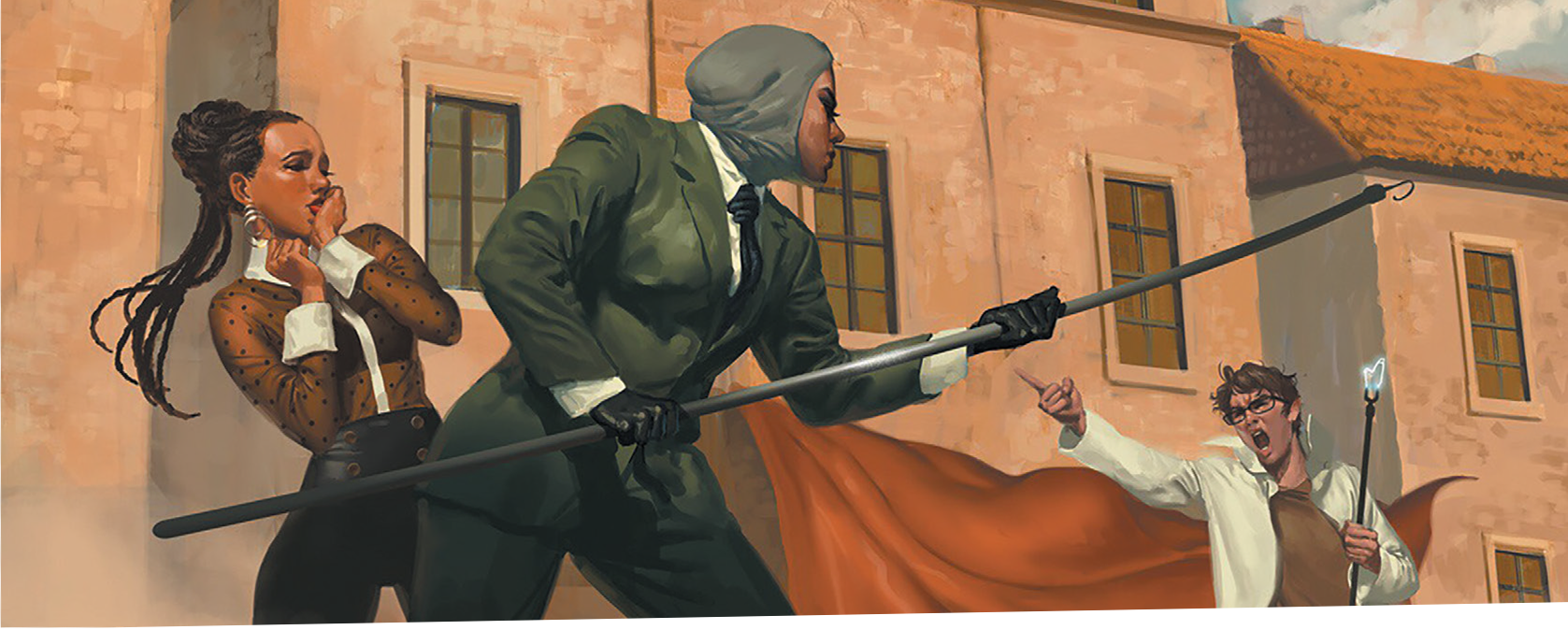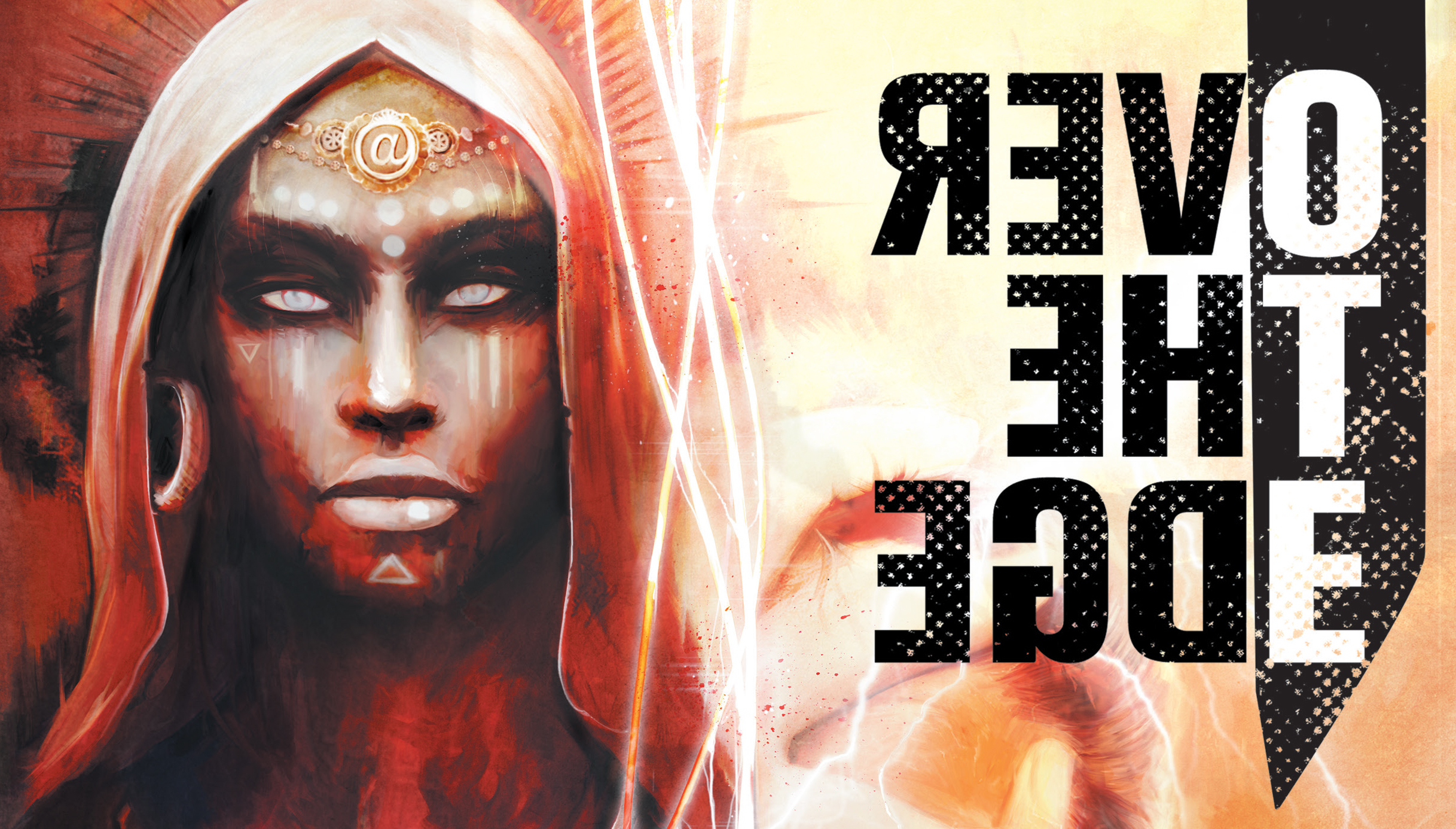Character creation in Over the Edge is hyper-fast. It’s so fast, in fact, that you can trivially do it with brand new players as part of a four-hour one-shot.
Character Concept: Virtually any character concept is possible in Over the Edge, but there are a few core principles that your concept should honor.
- They Are Human. They might be mutants, metahumans, prodigies, freaks, or ghosts. But they are fundamentally human.
- They Follow “Hollywood” Reality. Hollywood lies about how the world really works for all the right reasons, and you should, too.
- They Are Not Played Straight. If your character is a common archetype, give it one weird twist: Not just a vampire, but a recovering vampire. Or a vampire who drinks human tears. Or is addicted to sunlight.
- They Don’t Wreck Plots. Your character does not grant wishes, read minds, mind-control people, see the future, stop time, or otherwise trivially wreck plots.
Main Trait & Side Trait: Your character has a main trait and a side trait. You’ve probably already unwittingly picked them with your character concept.
- Traits are not mechanically predefined things. They’re not picked from a skill list. They’re not feats. They’re not classes or archetypes. You make them up.
- The difference between main traits and side traits is that main traits are broadly interpreted and side traits are narrowly interpreted. For example, if your side trait is MMA Fighter then you’re really good at fighting. But if it’s your main trait, then you’re also good at working the crowd, dealing with publicity, knowing other fight performers, sizing people up, etc.
Level: Generally speaking, beginning characters will be Level 2.
Trouble: Your character’s Trouble is what lures or provokes them into doing unwise things from the perspective of the game world that are constructive or exciting for the players. It’s your excuse to do things that are fun instead of pragmatic. For example, you might listen to an imaginary friend. Or brag and say too much. Or take risks to help an innocent in danger.
Question Mark: This is the best part. An adjective or short phrase that describes a major truth about your character’s reputation or personal identity.
- They should not be capabilities (like Persuasive-? or Intimidating-?). Your traits describe your capabilities.
- Generally speaking, the question mark does NOT imply that this is something your character is uncertain or wishy-washy about. It is usually fundamentally true. The function of the Question Mark is to telegraph on the meta level that this fundamentally true thing might STOP being fundamentally true during play. For example, a Priest who is Faithful-? isn’t necessarily fully of doubt at the beginning of the game; but her player is saying that something might cause them to question their faith during the game.
- It’s usually best not to name in advance what will trigger the Question Mark: We want to discover that during play.
A good example of this is Indiana Jones: He’s Brave-? Totally brave. All the time. Until we discover, in play, that he’s terrified of snakes.
Tells: Tells are observable details the correlate to your characteristics. For example, a character with the Linebacker trait is… built like a linebacker. The Semi-Feral Brawler sniffs new people they meet. The Hacker is always wearing AR glasses.
- You assign tells for your Main Trait, Side Trait, Trouble, and Question Mark.
Group Questions: You wrap up character creation with a round of group questions. Every player should ask one question of another player & every player should also be asked a question about their character.
- Open Questions are the gentlest. (e.g., What hobbies, arts, activities, or interests does your character pursue?)
- Leading Questions put the character’s identity under another player’s influence. (e.g., What caused you to suddenly stop painting?)
- Really Leading Questions push hard. (e.g., How do you keep your superiors at the Church from finding out about your sex tourism habits?)
A player is always free to refuse a leading question or to reject the premise and answer it however they like.
And that’s it! Because it involves more open-ended creativity, it doesn’t quite work like Character Creation in 5 Sentences for D&D or Character Creation in 7 Sentences for Magical Kitties Save the Day, but it’s very similar in practice. I can usually get a whole table up and running with new characters in just 15-20 minutes, which usually also includes introducing them to the rules.
REAL CHARACTERS
Because character creation is so quick, I’ve done it A LOT over the past couple of years. I thought it might be fun to share some of these characters from actual play as an example of the sort of crazed creativity the setting and system of Over the Edge inspires. Because of the nature of the game, these are also fully functional pregenerated characters: Just add a starting Level and a round of Group Questions and you’re good to go!
JOJO
- Main Trait: Asasssin
- Side Trait: Ex-Circus Clown
- Trouble: Imagines his own personal soundtrack (and is heavily influenced by it).
- Bloodthirsty-?
I0
- Main Trait: Zen Coder
- Side Trait: Martial Artist
- Trouble: Locks are a challenge, not a statement.
- Structured-?
KEN
- Main Trait: Ex-SWAT
- Side Trait: Youtube Conspiracy Master
- Trouble: The Truth Is Out There
- Self-Confident-?
LODGE
- Main Trait: Spiritual Lodge (channels entities)
- Side Trait: Intermittently Institutionalized
- Trouble: Follows old souls.
- Mercurial-?
LADY
- Main Trait: Anger
- Side Trait: Zombie
- Trouble: Impulsive
- Trusting-?
ED SIMS
- Main Trait: Drifter
- Side Trait: Bad Luck
- Trouble: Enjoys upsetting bigger men.
- Honest-?
DR. ED SEXY
- Main Trait: Sexual Healing
- Side Trait: Kinkomancy
- Trouble: I listen to my dick.
- Likable-?
THE BIG DUDE
- Main Trait: Meta-Tourist
- Side Trait: Elementary School Teacher
- Trouble: Talks down to people.
- Innocent-?
JONATHAN TWEET
- Main Trait: Immortality
- Side Trait: Telling Aloofness
- Trouble: Turns the page.
- All-Knowing-?
(Yes, someone decided to play the designer of the RPG that they were playing. That’s the kind of crazy awesomeness that Over the Edge inspires.)
REE REYES
- Main Trait: Geekomancer
- Side Trait: Barista
- Trouble: Protective of their friends.
- Confident-?
SISTER PROMISE
- Main Trait: Inspirational Nun
- Side Trait: Sees what others cannot
- Trouble: Compelled to help the faithless.
- Selfless-?
RICK LEE
- Main Trait: Accidental Boddhisatva
- Side Trait: Successful Business Consultant
- Trouble: Existentially inquisitive.
- Determined-?
“SLOW HAND” LUKE
- Main Trait: Slow Gunslinger
- Side Trait: Animal Lover
- Trouble: 100% White Hat
- Confident-?
JERRY
- Main Trait: Assembled Man
- Side Trait: Well Read
- Trouble: Can’t Die
- Holding It Together-?
BOOKER
- Main Trait: Noir Detective
- Side Trait: Optimistic
- Trouble: Can’t say no to someone’s face.
- Straight-Edged-?
NEVAEH
- Main Trait: Socialite
- Side Trait: Insect Talking (But Not Wasps)
- Trouble: Can’t Resist Dirt
- Ruthless-?
LITA
- Main Trait: Con Artist
- Side Trait: Ghost
- Trouble: Vengeance
- Greedy-?
GARAMOND
- Main Trait: Crime Boss
- Side Trait: Exotic Artifact Collector
- Trouble: Collection Builder
- Former Criminal-?
EMERIC RAI
- Main Trait: Erotic Chef
- Side Trait: Knife Skills
- Trouble: Seeking ingredients
- Overconfident-?
MINOR TOM
- Main Trait: Astronaut
- Side Trait: Cosmic Abilities
- Trouble: No short term memory
- Expert-?
MORE OVER THE EDGE @ THE ALEXANDRIAN
Over the Edge: System Cheat Sheet
Over the Edge: One Weird Twist
Design Notes: Scenario Hooks for Over the Edge
Design Notes: Scenario Tools
Behind the Scenes: Welcome to the Island














“They Don’t Wreck Plots”
…But, you always say “don’t prep plots”, so there shouldn’t be anything to wreck? 😉
@Doodpants Just because the GM shouldn’t be prepping a plot in advance doesn’t mean you don’t want a plot to happen. Ideally plot emerges from the player characters and their choices interacting with the world and situations the GM introduces.
Yeah, it says “Don’t Wreck Plots”, not “Don’t Wreck Prep.” It’s players’ sacred right to wreck your prep as often and as thoroughly as they can.
“Don’t Wreck Plots” could probably be equivalently phrased as “Don’t Ruin the Fun for the GM or Other Players”. That is, if you as GM feel comfortable running an entertaining game in which one of the PCs can grant wishes, well, go for it. But among the reasons that could go wrong is, if you don’t manage that well, it could easily make the other players feel like their characters are trivialized.
I’d love to hear more about the first core principle, “They Are Human.” A couple decades ago, I played in a 2nd edition Over The Edge campaign that had at least two characters* who were not humans, and it worked just fine.
Are there changes from 2E to 3E that make it harder to support really weird character concepts? Or is it more about the constraints of a four-hour one-shot?
(*One was a guy with a sword – except it was actually the sentient sword that was the character, possessing an ordinary human. The other was an Indefinite Elephant: a full-on elephant, but only a couple aspects of it at a time would be manifest or noticed. There may have been others, but we didn’t start out knowing one anothers’ character concepts, and only figured them out through gameplay…)